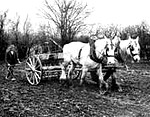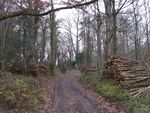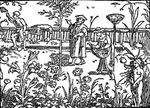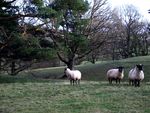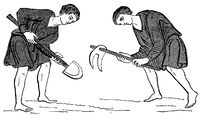| ||||||||||||
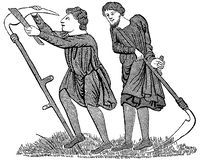 | Agriculture in Ewyas Lacy has always, so far back as the records go, encompassed both arable and livestock farming, although the balance between the two has varied significantly over the centuries. The management of woodlands for timber [forestry] and the cultivation of gardens and orchards [horticulture] have also been important local activities. Little information about farming in Norman times has survived, but Ewyas Lacy probably followed the normal feudal pattern of subsistence farming. Arable farming was very labour intensive, and so the areas cultivated were probably kept to the minimum required to produce sufficient corn for human consumption. Livestock would often graze on common land and - with the Lord of the manor's permission - on rough pasture in forests and waste land. The term 'Forest' at this time was used for land reserved for hunting by the aristocracy and was not necessarily woodland, though timber was grown as a valuable resource and coppicing was a widespread practice. | |||||||||||
| By the sixteenth century the rise in the wool trade signalled the beginnings of a sustained revolution that would eventually transform English agriculture, although its impact in Ewyas Lacy seems to have been relatively muted. Nevertheless, there is evidence of much greater emphasis on sheep farming in the area at this time. Fields, waste land, forest and commons were increasingly enclosed to accommodate livestock, with substantial social and economic consequences for the peasant classes as their traditional commoners' rights were usurped while the landowners profited. The eighteenth and nineteenth centuries saw further significant changes to English agriculture as mechanisation and new scientific approaches boosted agricultural productivity while the industrial revolution created wider markets for farm produce. Farming changed from a subsistence activity to a commercial business, and the records show significant increases in the area of land being farmed in Ewyas Lacy as enclosures continued. More of the better land was also given over to arable farming as new markets for corn opened up at the same time as the demand for animal fodder crops increased as a result of more intensive livestock farming on newly enclosed land. However, the evidence also suggests that traditional farming methods persisted in Ewyas Lacy long after they had been supplanted elsewhere, and this perhaps reflects the increasing isolation of the area as the political importance of the Welsh Marches diminished after the middle ages. Follow the links below to browse the historical record for information on the various aspects of farming in Ewyas Lacy over the centuries. | ||||||||||||
| ||||||||||||
| ||||||||||||
Ref: rs_sub_11

